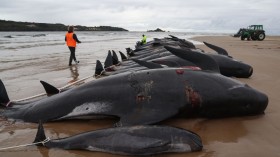Researchers have now found at least three different types of toxins from the algae that are choking the Indian River Lagoon, according to media reports.
"We have found a number of toxins, I think at least three varieties," said Peter Moeller, a research chemist at the National Ocean Service in Charleston, according to Florida Today.
These chemicals might have led to the increased number of animal deaths in the lagoon. The worst affected have been the manatees, that acquired high levels of toxins in their bodies after eating seaweeds growing in the lagoon. Over 100 manatees have died in the past year along with 300 pelicans and 50 dolphins.
The latest study was conducted by Peter Moeller, a research chemist at the National Ocean Service in Charleston and colleagues, Associated Press reported. Moeller said that he isn't sure about the kind of algae that has been producing these toxins.
He said that the next step in the research would be to identify the molecular structure of the toxins and see whether they are present in the tissues of pelicans and manatees.
The Indian River Lagoon occupies about 30 percent of Florida's East Coast and is a part of a chunk of the longest barrier island in the United States. The lagoon is a complex system and has high biological diversity.
However, IRL has now obtained the reputation as a dolphin graveyard as many dolphins have also been found dead in the recent years from either choking on fish or recreational gear.
© 2024 NatureWorldNews.com All rights reserved. Do not reproduce without permission.





